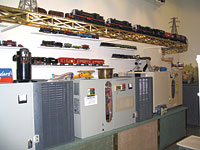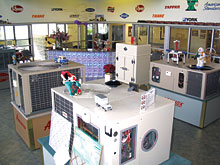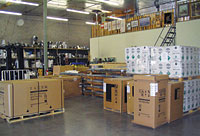
As Karl Zellmer, vice president of air conditioning sales for Emerson's Copeland Corp., noted, "Many contractors are now beginning to understand that they will need to upsell benefits like comfort, indoor air quality, reliability, and quality of services to continue to be successful."
While many contractors are relatively upbeat about the 13 SEER mandate, they still have some serious concerns as the industry moves closer to the 13 SEER transition. These concerns range from product availability to quality issues, and mismatched systems to larger component sizes.
Mismatched Systems
"I see this transition as one of the absolute best opportunities we've had in years," said Bob Barnes Jr., vice president and general manager, Western Heating and Air Conditioning, Boise, Idaho. "It's affected us in such a positive way. It's been nothing but an opportunity to make more money and sell up."
Barnes stated that he is not making the same mistake he made when the industry transitioned from 8 to 10 SEER. "Back then we bought up as much 8-SEER equipment as we could and advertised that we had the cheaper stuff. I see the 13 SEER issue as an opportunity to go the other way. I'm just glad we did because we're fully ready to go."
Even though Barnes is excited about the new mandate, he is a little nervous about how the consumer will fare with the changes. Specifically, he's worried about contractors who will install a new 13-SEER condensing unit but not match it with the proper indoor coil.
"With an air conditioner, I can install a 13-SEER unit tomorrow, and it can be nowhere near 13 SEER operating efficiency because I didn't properly install it or I didn't match it with the proper indoor coil," said Barnes. "There's no way to protect the consumer from that. A lot of people think they don't have to change out the indoor coil because the new unit will work with the old coil, and that could be the wrong answer."
Barnes stated that they will have to educate each customer about properly matching the outdoor and indoor coils. Chances are pretty good that he'll soon have a customer comparing his quote to a competitor's, yet the competitor will not include the new indoor coil in the bid. But that contractor probably won't be telling the customer that the system will not be 13 SEER without a new indoor coil. But consumers need to be told, and that's what we're going to do," he said.
[Editor's note: Some older coils, given the proper metering device will in fact work with newer condensing units. There is no one answer fits all. Contact your own distributor or manufacturer to get the details on matching systems.]

Size Matters
Christine Colditz, co-owner, LACO Mechanical, Palatine, Ill., is also looking forward to the 13 SEER transition because the government is essentially forcing customers to purchase upgraded equipment. "I would've preferred to see 12 SEER as the minimum, as opposed to 13 SEER. I don't necessarily think that was the way to go," she said.The 13 SEER mandate and the subsequent uncertainty regarding product availability has led many contractors, including Colditz, to change how they do business. "My proposals now say that 10- and 12-SEER equipment is subject to availability and cost changes. If they don't make up their minds in 30 days, I don't want that price sitting out there any longer. If they want a 12 SEER, sometimes I only give them 15 days, because right now, 12 SEERs are tighter in demand than 10 SEERs," she noted.
Even though some equipment is in short supply, Colditz did not see a benefit in stockpiling units before the transition. "We're not going to be the bank to our consumers. You can't stockpile enough to make a significant difference, so why tie up your capital? Both of our distributors are ordering more, and that's fine. It's a stopgap measure. Sooner or later we've got to come off the diving board, so why not sooner than later?"

Unfortunately, that doesn't help her out now, particularly where her condominium customers are concerned. She has notified them about the upcoming changes, suggesting they might want to consider replacing aging equipment now. Especially considering that the Department of Energy regulations regarding "thru-the-wall" systems are rather vague. There are many conditions and size limitations, and the newer units may not fit where they were originally installed.
"I have asked for the sizes of the new fan coil units, and the manufacturers tell me they don't have them. Well, when are they going to have it? What are they going to do about equipment in crawl spaces? When you start looking at the evaporator coil, there are so many restrictive spaces," said Colditz. "I understand one manufacturer showed that their furnace with a coil stood almost 6-ft high. How can you fit that in a basement?"

Product Availability And Pricing
Florida's energy code already states that 12-SEER equipment has to be installed in new construction projects, so John McMillan, president, Hearth & Home Heating and Cooling, Melbourne, Fla., isn't as concerned over the larger size of the components as he is over product availability. The majority of McMillan's work is in new construction, and he said that without better pricing information and availability guidelines, he is just struggling to get by.Equipment is especially scarce in Florida and along the Gulf Coast because of the back-to-back hurricanes that damaged many homes and businesses earlier this year. In addition, "Many manufacturers don't even have 13-SEER products to give us. Some don't even have the 14-SEER units available. The 12-SEER units are in short supply, so we're in a lurch right now just trying to provide equipment to our vendors," said McMillan. "This is December in Florida, which is supposed to be our low season, but we can't get product for our customers."
In order to get the badly needed 12-SEER equipment for his business, he's switching to different brands - and different distributors. McMillan did not pre-order large quantities of 12-SEER systems, because like many other contractors, he did not have the capital or the storage space to stockpile equipment. He ordered the equipment he needed for the projects he had bid, and he notified builders that his prices may increase if 12-SEER units became unavailable.

Pricing is another issue McMillan is struggling with, as many manufacturers have not released the price lists for their 13-SEER lines. "The transition phase has not been smooth as far as being able to get pricing to our builders and put out quotes for the next six months to a year. I think the manufacturers are waiting to see what everyone else does first. They want to see what the market will bear."
McMillan sees pricing remaining a problem for years to come. "My quotes are now good for three months, or else they're subject to a price increase. Last year we had instances where the manufacturers raised prices in December, then raised them again twice during the year. I used to be able to get a price list for the entire year. Now it goes up 10 percent and 12 percent, and I can't take that kind of a hit."

Quality Concerns
Joe Hendel, owner, Hendel's Refrigeration and Heating Inc., Chandler, Ariz., is in a unique position for a contractor in that he receives his equipment by the truckload from manufacturers. His 14,000-sq-ft warehouse is stocked with systems from just about every manufacturer. All the systems are displayed in his large showroom, as Hendel believes strongly in giving customers a choice of all available brands and options.Even buying directly from the manufacturer does not give him an inside track on pricing, though. "Our suppliers have been reluctant to give us new pricing information. The name of the game is, they're waiting to see what everybody else does."
Hendel did not buy large quantities of 10- to 12-SEER equipment, because many of his customers request 13-plus-SEER equipment. With many homeowners' summer utility bills in this area topping $300/month, customers are especially interested in the higher efficiency units that Hendel has on display in his vast showroom.
"All the units are operational in the showroom, and they have electric meters on them," said Hendel. "Customers can see that the older air conditioners draw about 30 amps, while the newer ones draw 11 or 12 amps. That really gets their gears turning, and they're usually willing to spend a few more dollars to get higher efficiency equipment. We just give them the information, and they make the decision."
Given that Hendel already installs higher efficiency equipment, the 13 SEER mandate doesn't bother him too much.
No one has a crystal ball to predict exactly how the 13 SEER mandate will ultimately affect contractors. Based on the concerns raised here, though, there will be a lot to talk about in the months to come.
Publication date: 12/19/2005




